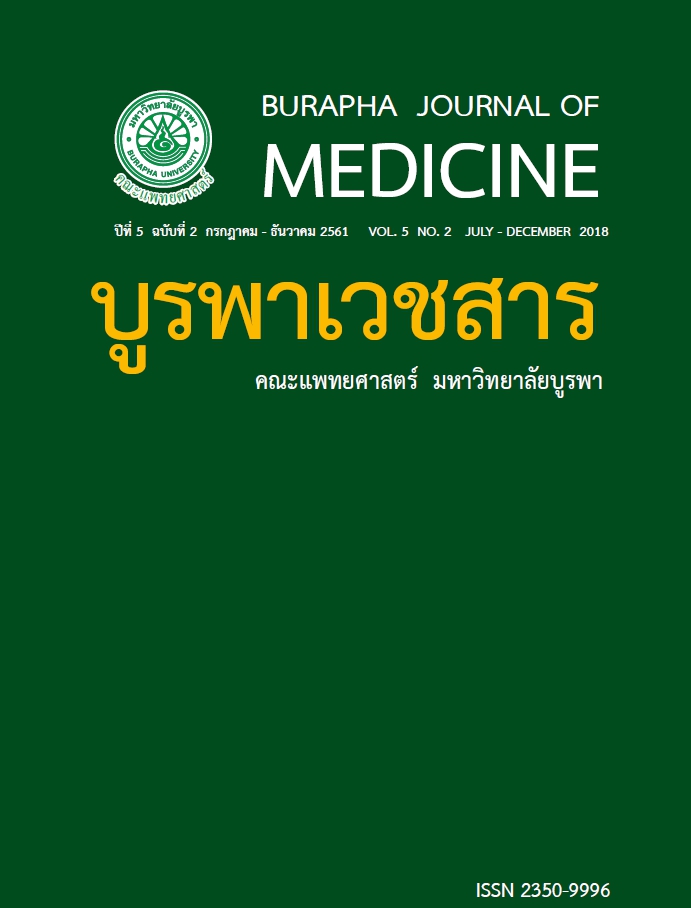การพัฒนารูปแบบการฟื้นฟูสภาพผู้สูงอายุเจ็บป่วยเรื้อรังโดยครอบครัวและชุมชนมีส่วนร่วมบน พื้นฐานแนวคิดเศรษฐกิจพอเพียงและภูมิปัญญาไทย
คำสำคัญ:
ผู้สูงอายุ, การฟื้นฟูสภาพ, การมีส่วนร่วมของครอบครัว, เศรษฐกิจพอเพียง, ภูมิปัญญาไทยบทคัดย่อ
Objective To develop a rehabilitation model for chronically ill older adults through family
and community participation, based on the Sufficiency Economy concept from Thai wisdom.
Design, setting, and participants This developmental research study was divided into two
steps: a) to interview a focus group; and b) to hold brainstorming meetings to develop said
rehabilitation model. Sixty samples who were chronically ill older adults (and their caregivers),
an administrator (the Mayor of the City), community leaders, nurses, health volunteers and
district members in this selected community were recruited. Data was gathered through indepth
interviews with the focus group, following effective interview guidelines.Content analysis
was performed for data, with an examination of all collected samples from the brainstorming
techniques.
Results The rehabilitation model consisted of 6 processes: (1) a policy to take care of older
adults by municipality administrators and community leaders (i.e., setting up an elderly care
program into the municipal administration policy and community work plan; (2) planning for
elderly rehabilitation by all relevant persons in the community; (3) the implementation of this
plan by all relevant persons; (4) the evaluation of this plan by the elderly, family members,
community leaders, health volunteers and nurses; (5) to monitor the progress and feedback
from the health volunteers, community leaders and nurses – including the progress of the
rehabilitation presented as feedback to the elders and their families; and (6) to complete
the elderly rehabilitation administration system (which the municipality should manage). This
system should include for each elder, his/her sicknesses and needs of rehabilitation, relevant
personnel supervision, as well as the necessary rehabilitation equipment and necessary support
of said equipment.
Conclusions Findings suggested all relevant personnel responsible for chronically ill older
adults should implement and apply this proposed rehabilitation model for their clients in the
community, so as to promote their health and prevent complications. Additionally, effectiveness
of using this rehabilitation model is recommended for further study.
เอกสารอ้างอิง
สถานการณ์ผู้สูงอายุไทย ปี 2559. นครปฐม:
พริ้นเทอรี่; 2560.
2. สมศักดิ์ ชุณหรัศมิ์. สถานการณ์ผู้สูงอายุไทย
พ.ศ. 2552. กรุงเทพมหานคร: ทีคิวพี; 2552.
3. วรรณภา ศรีธัญรัตน์ และ ผ่องพรรณ อรุณแสง.
การสังเคราะห์องค์ความรู้เพื่อจัดท?ำข้อเสนอการ
ปฏิรูประบบบริการสุขภาพและการสร้างหลัก
ประกันสุขภาพส?ำหรับผู้สูงอายุไทย. ขอนแก่น: คลัง
นานา; 2545.
4. จันทร์เพ็ญ สมโน. ความร่วมมือในการรักษาและ
ภาวะซึมเศร้าของผู้ป่วยที่มีภาวะหัวใจล้มเหลวใน
โรงพยาบาลเชียงใหม่ราม [วิทยานิพนธ์]. เชียงใหม่:
มหาวิทยาลัยเชียงใหม่; 2551.
5. Lehnert T, Heider D, Leicht H, Heinrich
S, Corrieri S, Luppa M, et al. Health care
utilization and costs of elderly persons with
multiple chronic conditions. Med Care Res
Rev. 2011; 68: 387- 420.
6. Resnick B, Boltz M, Galik E, Pretzer- Aboff, I.
Restorative care nursing for older adults: A
guide for all care settings. 2nd ed. New York:
Springer Publishing; 2012.
7. มูลนิธิชัยพัฒนา. จุดเริ่มต้นแนวคิดเศรษฐกิจ
พอเพียง. [อินเทอร์เนท]. เข้าถึงเมื่อ: 19 สิงหาคม
2559. เข้าถึงได้จาก: http://www.chaipat.or.th/
site_content/34-13/3579-2010-10 -08-05-
24-39.html
8. สัมฤทธิ์ พุ่มสุวรรณ, องุ่น ลิ่ววานิช, ยนต์ มุสิก และ
วิริยะ สิริสิงห์. สารานุกรมไทยส?ำหรับเยาวชนโดย
พระราชประสงค์ใน พระบาทสมเด็จพระเจ้าอยู่หัว
ฉบับเสริมการเรียนรู้. กรุงเทพมหานคร: โครงการ
สารานุกรมไทยส?ำหรับเยาวชนโดยพระราช ประสงค์
ในพระบาทสมเด็จพระเจ้าอยู่หัว; 2550.
9. วีณา เที่ยงธรรม, สุนีย์ ละก?ำปั่น และ อาภาพร
เผ่าวัฒนา. การพัฒนาศักยภาพชุมชน:แนวคิดและ
การประยุกต์ใช้. กรุงเทพมหานคร: ภาควิชาการ
พยาบาลสาธารณสุข มหาวิทยาลัยมหิดล; 2554.
10. จรัญญา วงษ์พรหม, คีรีบูนย์ จงวุฒิเวศย์,
นวลฉวี ประเสริฐสุข และ นิรันดร์ จงวุฒิเวศย์.
การมีส่วนร่วมของชุมชนเพื่อพัฒนาคุณภาพชีวิต
ผู้สูงอายุ. Veridian E-Journal, Silapakorn
University. 2558; 8: 41-54.
11. รัถยานภิศ พละศึก, เบญจวรรณ ถนอมชย
ธวัช และ ดลปภัฎ ทรงเลิศ. การวิจัยเชิงปฏิบัติ
การแบบมีส่วนร่วม: กระบวนการพัฒนาการ
สร้างเสริมสุขภาพชุมชนอย่างมีส่วนร่วม. วารสาร
เครือข่ายวิทยาลัยพยาบาลและการสาธารณสุข
ภาคใต้. 2561; 5: 211-23.
12. ขวัญเรือน ชัยนันท์, สุรีย์ จันทรโมลี, ประภาเพ็ญ
สุวรรณ และ มยุนา ศรีสุภนันต์. การพัฒนา
รูปแบบการดูแลสุขภาพช่องปากผู้สูงอายุโรคเรื้อรัง
เทศบาลนครรังสิต จังหวัดปทุมธานี. วารสาร
เครือข่ายวิทยาลัยพยาบาลและการสาธารณสุข
ภาคใต้. 2561; 5: 91-107.
13. Kulprasutidilok A. Community-based
participatory research in elderly health
care of Paisanee Ramintra 65 Community,
Bangkok, Thailand. Inter Scho Sci Res Inno
2016; 10: 2039-43.
14. Takahashi M, Araki A, Watanabe S, Haga
H, Kimbara Y, Tamura Y, et al. Community
participation is associated with life
satisfaction in elderly people with diabetes
mellitus. Japanese Journal of Geriatrics
2010; 47: 140-6.
15. English E. The effect of community
participation on subjective well-being in
community dwelling elders [Internet].
Accessed: Mar 5, 2018. Available from:
http://citeseerx.ist.psu. edu/viewdoc/
downlo ad?doi=10.1.1.895.2270&rep
=rep1&type=pdf



